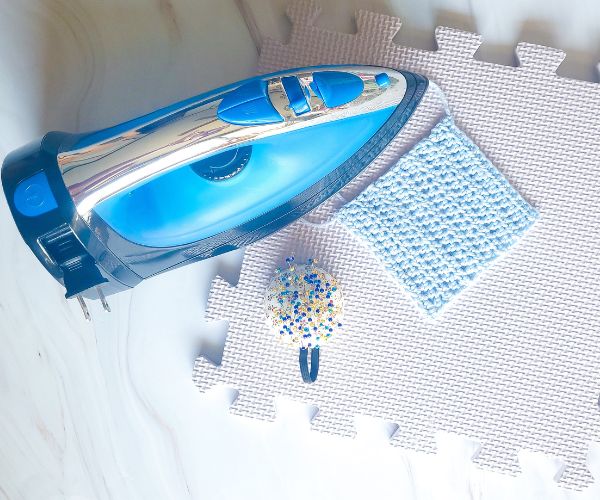Of the three common blocking methods, steam blocking is the fastest but requires more tools. In this article, we will answer the following questions about steam blocking:
- What is steam blocking?
- What projects benefit from steam blocking?
- What tools will you need for steam blocking?
- What steps are necessary to steam block?
What Is Steam Blocking?
One of the three blocking methods, steam blocking is a finishing technique that allows your yarn fibers to relax and open up.
This blocking method can be used on projects that are pinned in place or hung up neatly. Steam is applied using either a garment steamer or the steam function on an iron, while the finished crochet piece is stretched to shape.
Learn more about blocking in general, wet blocking, or mist blocking.
What Projects Benefit From Steam Blocking?
Since steam blocking is the simplest form of blocking, any crochet project will benefit from this finishing technique.
Large Projects
Blankets and some garments are often too big to wet block unless you use the bathtub to soak them.
Even so, they take such a long time to dry, that blocking becomes a massive chore.
With steam blocking, the process can be done in minutes instead of days and with much less effort.
Cotton Projects
Cotton yarn benefits especially from steam blocking since stitches made with this fiber tend to stretch over time. Steam blocking relaxes the fibers but also sets the shape in place to reduce the amount of stretching that happens over time.
What Tools Do You Need for Steam Blocking?
Contrary to wet blocking or mist blocking, you only need a few household items to steam block. Of course, you can always upgrade to better-quality materials as needed.
Read more about crochet blocking tools.
Ironing Board
Instead of using blocking mats, use an ironing board as your blocking surface. Blocking mats will melt under the heat of steam tools.
Garment Steamer or Iron With Steam Function
A high-quality steamer works best, but you can use a good iron in a pinch.
Fabric Starch (Optional)
On cotton projects, like doilies, curtains, blankets, and other household items, I like using a small spritz of starch to perfume the finished item and help the stitches hold their shape longer.
What Steps Are Necessary to Steam Blocking?
Steam blocking is easy and can be completed in just two steps!
Step 1: Prepare Your Project
For garments, hang them from a garment hanger. For blankets, table runners, and other flat projects, lay them out on the ironing board as best you can.

Step 2: Steam
For hanging projects, use a garment steamer for the best result, then allow to cool before removing it.
For projects on the ironing board, use the steam function on the iron and hover over the project, allowing the steam to permeate the stitches while you shape the project as desired. Lay flat and allow to cool.
A Word of Caution
Only steam block natural fibers, like cotton or superwash wool. If you choose to steam block acrylic or polyester yarn, pay close attention to the heat settings on your steamer or iron. Synthetic fibers will melt under high heat and damage your iron.
Quick and Easy
The steam-blocking method is the first form of blocking I learned as a young crocheter. I used my steam iron to give my crocheted doilies and lace a little extra shape and spritzed them with starch for that nicely scented touch before giving them to friends and family.
Steam blocking is the quickest and easiest way to give your projects a little professional finish. Will you try steam blocking your next project?


